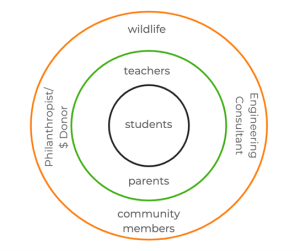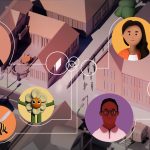Experiential Learning Activities
The following experiential learning activities can be used by instructors to have their students reflect on and attend to the cognitive biases discussed above. The activities are designed to be used in either a virtual or in-person environment.
A Sample of Workshop Agenda and Facilitator’s Guide is provided alongside a Sample Slide Deck for instructors to use as part of a workshop. A minimum of two hours is suggested to run both activities for a small class (e.g., up to 20 students). For larger classes, more time will be required to move between break-out sessions and for discussion in the main room.
Note: For Activity 1, a Characters Descriptions document is also created with a series of character cards that can be used by instructors in any way they want.
Character Cards: A sample of Character Cards are designed for each scenario of he role play activity, that can be used by the facilitators to engage the learners in the process.
- Maggie V1
- Maggie V2
- Issac V1
- Issac V2
- Flower V1
- Flower V2
- Bee V1
- Bee V2
- Catherine V1
- Catherine V2
- Estelle V1
- Estelle V2
- Role Play Map
- P_Estelle V2
- P_Estelle V1
- P_Flower V1
- P_Flower V2
- P_Issac V1
- P_Issac V2
- P_Maggie V1
- P_Maggie V1
- P_Catherine V1
- P_Catherine V2
Activity 1 – Empathy Role Play
The objective of this activity is to help students become aware of and address the “egocentric empathy gap.” This bias causes innovators to overestimate the similarity between what they value and what others value, and to project their own thoughts and preferences onto others. Creating awareness will make it easier for students to recognize the importance and value of learning from the end-user and other stakeholders during the design process.
In this exercise, students are presented with a scenario and introduced to various stakeholders who may be affected by the proposed design project. Students work in small groups where each person takes on the role of one character while a facilitator (either another student or an instructor) guides the discussion. The exercise is completed in two cycles: each framed by a different “mood.” Reframing the discussion using a new emotion that might be viewed as “opposing” the previous (e.g., one is “positive” while the other is “negative”) should elicit different perspectives – even from the same character! This will emphasize to participants that the points of view of diverse stakeholders should be considered without judgement and without assuming that their values will align with those of the designer. Taking into account different perspectives will ensure the creation of new ideas that are valued by the intended beneficiaries of the design.
Step 1 – The Scenario
Introduce the scenario to set the scene for the discussion:
Students at the Concrete Jungle Secondary School love to spend time in nature but feel restless and bored at their school where there is no green space. A wealthy philanthropist has offered to make a large donation to the school to design an “outdoor classroom.” Their only stipulations are that the classroom or learning space
- be accessible to the wider community, and
- must promote environmental sustainability.
You might consider asking students what is meant by the following terms, keeping in mind that there are no “right” or “wrong” answers:
- outdoor classroom,
- wider community,
- environmental sustainability.
Step 2 – The Stakeholder Groups
Introduce the stakeholders using a Stakeholders Map. The primary beneficiaries – the students at the Concrete Jungle Secondary School — are identified at the center of the map. Additional stakeholders are those whose needs must be addressed, who have a say in the outcome, or who may be affected by the project or related decisions. Stakeholders are added to each ring of the map based on their degree of interaction or influence on the end-user: those closer to the center engage to a greater extent with the primary beneficiary than those further away.
The following Stakeholders Map may be provided to the students. Alternatively, as an additional exercise, challenge the students to identify the different stakeholders themselves and add them to map!

Step 3 – The Characters
This activity will focus on specific stakeholders; however, the exercise can be adapted for different characters or even a different scenario altogether!
The students – as their characters — have been invited to attend a community meeting to discuss the proposed plans for the outdoor learning space. In break-out rooms, they are to imagine they are playing one of the following roles:
- Maggie, representing her grade 9 classmates;
- Mr. Isaac, Maggie’s teacher;
- Estelle, a resident from the retirement home;
- The flower in the space between the school and retirement home;
- The bee flying near the flower;
- Catherine, a civil engineer and parent.
Divide the students into groups of 4 or 5 including one facilitator. Facilitators ensure that each person in their break-out room has a character (different from one another) with at least one person taking the role of “student.” Use the character descriptions, selecting one version of the character.
Step 4 – Break-out session
Make sure you have one person playing the role of Maggie in each room. Each facilitator selects a mood from the following list to frame the discussion:
- Excited
- Curious
- Relieved
- Empowered
The facilitator then chooses the first character to share a recent experience they’ve had as part of the school community. Don’t give them much time to think about it! After the person shares their story (~30 seconds), select the next person to respond with their own experience that conveys the emotion framing the discussion.
The facilitators should make sure everyone has had a chance to share at least once but mix up the order to keep them on their toes!
Step 5 – Main room
Prompt the students to think back to something that was said in their group conversation that was surprising or made them reconsider their initial perspective. They should then write their (paraphrased) quote in the chat window and include the character who said it. Have everyone wait to hit enter when the instructor says, “Go!”
Give the students time to read through the various quotes. Which quotes were most/least surprising?
Step 6 – Back to the break-out session with the same groups and characters
Have the students return to their break-out rooms. The facilitator in each break room will provide another emotion to frame the discussion. Facilitators should ensure that each person in their break-out room is back in their previous character. The facilitator then selects another mood from the next list to frame the discussion:
- Annoyed
- Worried
- Confused
- Resentful
- Resigned
Repeat the previous exercise, contributing to the conversation while conveying the emotion framing the discussion.
Step 7 – Main room
Again, have the students share another (paraphrased) quote about something unexpected they heard in the second break-out session. Use the chat window; have the students write their quote, including the character who said it, sharing once everyone is ready.
Step 8 – Reflection
Ask the students to reflect on the following questions:
- What was unexpected? Why?
- What did the surprising quotes suggest about what the different characters value? How is this similar/dissimilar to what your character values? How is this similar/dissimilar to what you value?
- How did the emotion that framed each discussion affect the values identified? Did the values stay the same or change for each character?
Summary of learning
As innovators embarking on a new design challenge for societal impact, it is important that we engage with different stakeholders to understand their different experiences. By listening actively and openly without judgement, we can empathize with diverse perspectives – both obvious and unexpected. Empathy can help us check our assumptions and overcome our biases by learning about what is valued by others. This will lead to ideas that have a greater chance of being embraced by those we wish to serve.
Design thinking allows us to check our assumptions by working with the beneficiaries of our designs at the outset of the process. Empathy for the primary user and different stakeholders exposes our “egocentric empathy bias” by recognizing that our values and perspectives are different from other people’s. The first design exercise emphasized the importance of talking to and learning from different stakeholders to ensure we do not assume what the “problem” is or design a solution to meet our own needs.
Activity 2 – PictoVisionary
This activity is focused on helping students understand Availability Bias. As discussed previously, the Availability Bias causes innovators to undervalue ideas that are harder for them to imagine. Since the familiarity of an idea is likely to be inversely related to its novelty, this leads to a preference for more incremental solutions.
In order to push students outside of what they know and believe to be possible today, PictoVisonary presents students with different “what if” scenarios that depict extreme future conditions that will impact their design. Students will consider the needs of the stakeholders from Activity 1 and brainstorm solutions within the context of these scenarios.
Brainstorm Challenge – How might we design a nature-based community learning environment or “classroom” that will create awareness about environmental issues and inspire action by all members of the school community?
The Sample of Workshop Agenda and Facilitator’s Guide provides an outline of the activity with suggested timelines.
Students can use online tools such as Whiteboard or Google Slides to help visualize their ideas. If in person, students can use sticky notes, pen and paper, or whiteboards.
Step 1 – Brainstorm Rules
Go over the 7 Brainstorming Rules with students [reference – rules adapted from IDEO/d.school]. Encourage them to have fun and remind them there is no such thing as an idea too wild! Give students the chance to ask questions about the brainstorming process.
- Defer Judgment (all ideas are good ideas)
- Encourage Wild Ideas (think big)
- Build on the Ideas of Others (Yes and…)
- Stay Focused on the Topic (remember what you are trying to solve)
- One Conversation at a Time (make sure everyone has the chance to contribute)
- Be Visual (sketch, copy pictures from the web, cut pictures of out magazines, etc.)
- Go for Quantity (ideas should not be perfect, try to get as many ideas as possible)
Step 2 – Initial Brainstorm
Break students into groups of 4-6 students. For the first round of brainstorming, students will brainstorm ideas without having been given a “what if” scenario. This will act as the base scenario on which students should reflect in comparison to the future scenario at the end of the activity.
As a whole group, and if time permits, each group will give a 30 second summary of their proposed solutions from the first round of brainstorming for their fellow students.
Step 3 – Future Scenario Brainstorming
Once the first round of brainstorming is complete, one of the “what if” scenarios is presented. Groups will then go through the same brainstorming process, this time based on the new scenario. Students will go work through this process for three different scenarios:
- What if… in 25 years from now global warming causes severe flooding and 90% of the planet is underwater.
- What if… in 50 years from now we can see in the dark, hear a pin drop in the next room, and smell odours as far away as the next city.
- What if… in 100 years from now we live in an anti-gravity world.
As with the first round of brainstorming, each group will give a 30 second summary of their proposed solutions after each round. Once they have presented their ideas, the next “what if” scenario will be presented, and the groups will break off to brainstorm again.
Step 4 – Reflection
As a whole group, ask students to reflect on their brainstorming and the opportunities presented by the “what if” scenarios. Encourage discussion using the following prompts:
- What opportunities have you identified in your “What if” solutions that might be applied to the current situation?
- What would have been lost in your “today” solution if you hadn’t been prompted to think about these “crazy” future scenarios?
- Would you have thought of these ideas/solutions if you hadn’t been prompted to think about these “crazy” future scenarios?
Summary of Learning
During the ideation phase design thinkers emphasize “going for quantity” — not judging ideas, but rather building collaboratively on team members’ ideas in divergent ways that will ultimately lead to innovative solutions. The second design exercise helped us think outside the box. By adding constraints to the design space, team members were actually compelled to consider different ways to make ideas work in unexpected contexts. The unfamiliarity of the environment allowed us to imagine new and creative ideas that could then be applied to the current situation, thereby overcoming the “availability bias.”
























